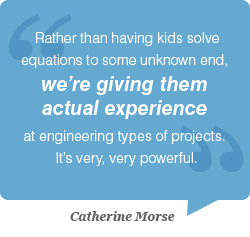Highlighting:
![]()

If you’re plugged into the news, then you’ve probably heard the buzzword — or, more accurately, the buzz-acronym — “STEM” by now. STEM — science, technology, engineering and math — is the leading edge of the next great educational wave, and with good reason: It’s the area that will have the most jobs and the best-paid jobs for the foreseeable future.
According to the U.S. Department of Commerce, STEM jobs nationwide will grow about 17 percent between 2008 and 2018, while other types of jobs are expected to grow less than 10 percent. Here in Central Texas, that surge is even more dramatic. Of the 43 occupations expected to grow fastest in that same time period, 20 are STEM occupations, and their growth rate is expected to be 23 percent. At the seemingly light-speed pace that technology is advancing, today’s kids will need core STEM competencies to succeed at almost any job.
But as solid STEM education has begun to rise in importance, America’s education system has begun to slide in the global marketplace. In 2009, among the 34 countries of the Organisation for Economic Co-operation and Development, half had higher average math scores than the U.S., and more than a third scored higher than the U.S. in science. In 2011, only 45 percent of U.S. high-school graduates were prepared for college math curriculum, and just 30 percent were ready for college science curriculum, according to ACT, a college-entrance testing agency. And, of the 4 million U.S. students who began ninth grade in 2004, only 4 percent will graduate from college this year with a bachelor’s degree in a STEM major.
Clearly, our country’s traditional means of teaching science and math aren’t working as well as they need to in this brave new STEM world. Not only must technology and engineering be incorporated, but the curriculum and learning environment also must become more engaging and effective to inspire more students to pursue STEM-based careers. In other words, passively sitting in a classroom, taking notes while a teacher lectures or regurgitating facts and formulas on a standardized test form, simply won’t make the grade in a STEM-strong future.
Samsung supports STEM education through products, jobs
Samsung Austin Semiconductor (SAS), one of America’s most advanced semiconductor manufacturing facilities, has a naturally vested interest in nurturing STEM education in Central Texas.
“We hire lots of engineers and technicians,” says Catherine Morse, SAS General Counsel and Director of Public Affairs. “And, as technology continues to integrate into people’s everyday lives, we’re going to be creating more and more jobs that require those sort of strong STEM skills. We also manufacture logic chips for some of the tools that are helping move STEM education forward, like notebooks, tablets and other ‘smart’ devices.”
Additionally, Samsung Austin invests in programs aimed at changing the way STEM studies are approached, starting with its own in-house Samsung STEM Academy.
“We bring high school students who have an interest in STEM subjects into our facility for a day and give them some training about what it is we do here,” Morse says. “Our engineers deliver the coursework, much of which is hands-on and interactive; we show them what engineers do, what sort of problems these people come to work to solve. Rather than having kids solve equations to some unknown end, we’re giving them actual experience at engineering types of projects. It’s very, very powerful.”
 Experts agree this hands-on, project-based approach to learning is the best way to make STEM accessible and appealing for students — and the best way to prepare them for their future workplace. In “learning labs,” kids discover how to collaborate, communicate, make real-world connections and apply concepts to solve problems, just as professionals do at their jobs every day.
Experts agree this hands-on, project-based approach to learning is the best way to make STEM accessible and appealing for students — and the best way to prepare them for their future workplace. In “learning labs,” kids discover how to collaborate, communicate, make real-world connections and apply concepts to solve problems, just as professionals do at their jobs every day.
“Critical thinking skills, intellectual curiosity, creativity, adaptability —these are the characteristics that will define who’s successful,” Morse says. “Kids must be taught to work as team members, to each take a part and bring it together, because where’s the company where someone works all alone to come up with a disruptive technology? That just doesn’t happen.”
Samsung partners with STEM programs that work
In addition to its own STEM Academy, Samsung Austin helps fund several area STEM-centric programs, such as United Way for Greater Austin’s Play To Learn initiative. To help economically disadvantaged families foster school-readiness at home, Play To Learn provides Samsung Galaxy tablets preloaded with children’s educational apps, bookmarked websites and parenting videos — leveraging the lure of technology and the gaming culture to introduce STEM concepts.
SAS also partners with Skillpoint Alliance, a local nonprofit organization working to help build college and career success for Central Texans, and to meet area employers’ needs for qualified workers. Skillpoint Alliance’s STEM Council, made up of high-tech executives and education leaders focused on the engineering and high-tech industries, promotes STEM education through more than a dozen robotics, green technology and digital media programs.
“Robotics is such a great way to get kids engaged,” Morse says. “It’s so experiential. Kids like gadgets. They’re enjoying it and having fun, and meanwhile, guess what? They’re learning physics and engineering.”
Samsung Austin has made a sizable investment in the E3 (Education Equals Economics)Alliance, a collaborative designed to develop career-readiness for regional competitiveness. During the past two years, the E3 Alliance has been working to deliver Texas Project Lead the Way curriculum to Central Texas schools. These project-based programs for middle- and high-school students are geared toward technology, engineering and biomedical sciences.
“E3 Alliance data shows kids who take these courses are actually enrolling in college engineering programs,” Morse says. “As a company, it’s nice to know for sure the dollars we’re putting into Project Lead the Way are really growing the number of kids pursuing STEM careers.”
This new wave of STEM education is still found mostly in specialized programs, and Central Texas has a way to go to evolve its typical, traditional science classrooms into project-based learning labs. But the teaching tide of science, technology, engineering and math has begun to turn — and for high-tech companies like Samsung Austin, it looks like it’s going in the right direction.
“We’re still learning as a society about how to best use technology to change how educational material is delivered, but we’re excited by the programs we’re presented with,” Morse says. “They’re fresh, they’re innovative, and their results are promising. As far as hiring, we’re not seeing a lack right now, but it’s something we’ve got to keep our finger on the pulse of. Central Texas is definitely making progress in terms of STEM education. It’s very, very encouraging.”










